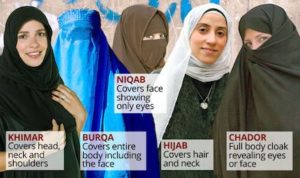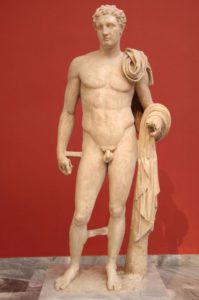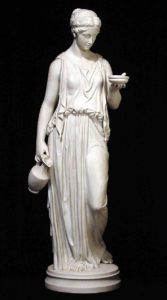“Somebody once said it’s what you don’t see you’re interested in and this is true.” Groucho Marx
1
On Fashion And “Islamic Fashion”
The title of this blog might cause confusion. Linking male homosexuality with a particular dress code for women must appear as puzzling at first, if not to say bizarre. I’ll show, however, that it is possible to point out male homosexuality as a cultural undercurrent for female Islamic dress code. Let’s start this discussion by pointing out the indisputable fact that seeing is definitely not the same as knowing.
On the contrary, something meant to be eye catching is many times meant to divert our attention from things we should not know. Being aware of this principle brings us closer to our topic. In aphorism 523 of Daybreak: Thoughts on the Prejudices of Morality, the philosopher Friedrich Nietzsche wants us to embrace a critical intellectual stance he refers to as “Hinterfragen”; which means literally: questioning from behind. “Whenever a person reveals something”, he says, we should always ask the question: “What is it supposed to conceal? From what is it supposed to divert the eyes? I strongly feel that this hermeneutical method of radical

suspicion is suitable for a discussion about the way women are dressed in the Islamic world. With Nietzsche’s concept of Hinterfragen in mind one can ask, for instance, what exactly is such a thing as the burka supposed to conceal? Is the burka really meant to fend off the eyes of men, or is the burka, perhaps, signifying a hidden, and completely different meaning? Since there is nowadays a passionate debate about the pros and cons of Islamic dress code for women I’ll start the discussion with some words about fashion.
Fashion is meant to be a festivity for the eyes. But fashion is much more than that.

Fashion is an important part of how we define ourselves. That’s why most of us spend some time in front of the mirror before leaving our homes. It is important for us to know what others will see when they see us. What we wear is always a talking mirror of our mind. It can be an understated whisper, a high energy scream, a smile, or an all knowing wink. Fashion wants us to be comfortable with ourselves. And we do feel comfortable with ourselves when we can say

what we want to say by wearing what we wear. Therefore, one can safely claim that fashion is one of the most dominant forms of free speech.
I think it goes without saying that fashion in that respect does not exist in the Islamic world. Fashion is a tool for individual differentiation. But dressing code for women in the Islamic world is producing a standardization, if not to say uniformity. Therefore, the expression “Islamic Fashion” is an oxymoron. But what exactly is it if it’s not fashion? A closer look at the Biblical Fig Leave can serve as an eye opener.
2
The Misunderstanding With The Fig-Leaves Clothing
First of all, the expression “fig leave” is used figuratively to convey the covering up of something that is seen as embarrassing or distasteful. It is the metaphorical reference to the Book of Genesis, in which Adam and Eve appear as mythological fashion designers by covering themselves with fig leaves after eating the forbidden fruit from the tree of knowledge. Even so there are many skilled Nietzsche readers among theologians, they have failed so far to read the story of Adam and Eve with Nietzsche’s method of radical suspicion. It is common standard to accept the interpretation as convincing that Adam’s and Eve’s nakedness caused some sort of an inferiority complex. And that they used fig leaves in order to cover their nudity.
However, it is not difficult to point out that this interpretation is wrong. Adam and Eve did not cover their genitals with fig leaves

because they discovered their nudity. It is something else that forced them to cover their genitals. What is it? I’ll give you a hint. Everyone frequenting nude beaches will certainly agree upon that peoples complete nakedness is not exactly “interesting” or exciting. When completely everything is revealed for the eyes then there is nothing left for the mind to “think” about. Generally, one tends to experience people’s complete nakedness in public places, such as nude beaches, as almost repellent. Why? The answer to this is of brutal simplicity: human genitals are ugly..
Consequently, the fig leaves were not meant to conceal nudity but ugliness. Besides, one can not exclude the possibility that the “discovery” of ugliness was the emotional big bang for aesthetic creation. “After all”, says Nietzsche, “what would be ‘beautiful’ if the contradiction had not first become conscious of itself, if the ugly had not first said to itself: “I am ugly”? Significantly, we find in the mythology of Adam and Eve an early interrelation between ethics and aesthetics; that it is morally good to conceal ugliness.
3
Nakedness, Culture and Sexual Orientation
I’m aware about the fact that one can’t talk about aesthetic aspects of nakedness without taking into account social contexts, culture and sexual orientation. We know by now perfectly well that ancient Greek culture and society, for instance, was closely interrelated with male homosexuality. The most widespread form of sexual relations in ancient Greece was between adult men and pubescent or adolescent boys. Ancient statues show us that complete nakedness of men was a social, ethical and aesthetic ideal. Women, on the other hand, were expected to cover their


flesh. Before I approach dressing code for women in the Islamic world I would like to tell you a small anecdote.
An acquaintance of mine and his fiance had invited me once to a bar. The fiance, her name was Rita, was really eye catching. Something between the young nymph in Stanley Kubrick’s “Lolita” and a lightly dressed porn star on vacation in a tropical paradise. The acquaintance was a tattooed, short tempered macho man. He asked me at some point: “do you see the guy over there?” By this he meant a male existence hanging around in the background of the bar. “If he looks once more at Rita” the acquaintance said, “I’m gonna kill him! I’m gonna shoot him right between the eyes!” I’ll come back to this anecdote with regard to the Islamic world in a moment.
4
The Hidden Origin Of Hijab, Niqab and Burka
Islam is said to be a complete code of life. However, as I have pointed out in my blogs on “Fashion and Terrorism” Islam is not a religion at all. It is an archaic form of fascism, misleadingly labelled as religion. When it comes to Islamic female dressing code one should not forget that the Quran is a book written by a male individual called Mohammed, and that dressing code for women are nothing but a strict order from the person who wrote the book. Mohammed demands that women

should guard their “modesty”, and not display their beauty “so that they may be recognized and not harassed” (Sura 24 and 33) Many Islamic countries enforce strict, draconian dress codes for women, which are routinely policed with brutal violence.
Now, one could easily assume that Mohammed’s views on femininity female dressing code is more or less identical with the macho psychology of my acquaintance. Suppose he is sick and tired to see that other men fantasize about certain things as soon they see his Rita and that he, God forbid, would force her to wear a burka. What would he gain from that? Nothing! On the contrary. Men would starring at her even more, fantasizing about the nude flesh under the burka.
For Rita, on the other hand, nothing would change neither. It wouldn’t make any difference for her to appear either completely naked on high heels or in a burka. The eyes of men starving for just one thing would focus on her appearance in both cases. Thoughts along this line show us that the burka doesn’t make sense at all. At least not in the way Mohammed has phrased it. His command that female dress code should function as a repellent against male sexual desires is logically not tenable.
Nietzsche’s method of radical suspicion brings us closer to the truth if we look at

this dress code from a male homosexual point of view. I know this sounds crazy since male homosexuality is despised in the Islamic world. We know that liberal sexual morality in the modern Western world is perceived by Muslim societies as an indication of decadence. It serves Islamist propagandists as a proof of Islam’s moral superiority. Strong moral condemnation of male homosexuality remains the majority opinion in the Islamic world. We know as well, however, that the Islamic world is inherently misogynistic. Misogyny, by definition, is an attitude of hatred for females because they are female. That a woman in Muslim societies is worth less than a man can not be seriously disputed. The only debatable point is by what degree. The Taliban in Afghanistan went so far to establish an apartheid system between men and women.
At this point one is confronted with a brain teaser. How can Islamic homophobia be compatible with Islamic misogyny? I’ll come straight to the point. Islamic homophobia diverts our attention from the fact that it must have homosexuality as its prerequisite. The extend of misogyny in Muslim countries, on the other hand, is not thinkable without homosexuality under the surface of homophobia.



Homosexuality was once considered the most natural thing in the Islamic world and it is an open secret that ancient Muslims borrowed homosexual habits from the ancient Greeks. Alexander the Great’s gay guy army had once upon a time conquered the entire Orient all the way towards an area that is nowadays called Pakistan. Taking all this into consideration it should not come as a surprise that Mohammed is not only promising virgins in his paradise but also nude young boys.
I think one has good reasons by now to drop the idea that “religion” or the macho guy psychology of my acquaintance can be related to Islamic female dress code. Moreover, to discuss this phenomenon from a heterosexual point of view has turned out to be fruitless. Nietzsche’s method of radical suspicion, on the other hand, has brought us closer to the truth.
If we ask what such things as hijab, burka and burkini are supposed “to divert the eye from” then we can discover a hidden cultural undercurrent. We can safely say that these things make a cultural undercurrent of male homosexuality invisible. Additionally, since misogyny must have homosexuality as its prerequisite we can conclude that female Islamic dress code implies the uglification of women and indicates a “homosexual-misogynist” apartheid system between men and women.


